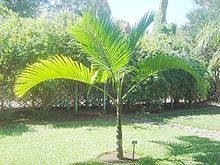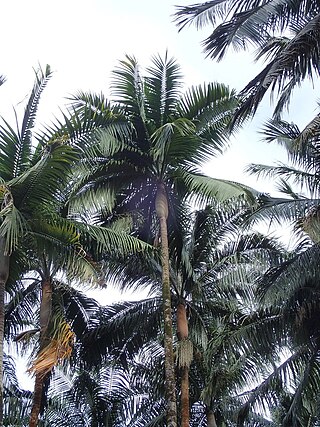
Acanthophoenix is a genus of flowering plants in the palm family from the Mascarene Islands in the Indian Ocean, where they are commonly called palmiste rouge. A genus long in flux, three species are currently recognized, though unsustainable levels of harvesting for their edible palm hearts have brought them all to near extinction in habitat. They are closely related to the Tectiphiala and Deckenia genera, differing in the shape of the staminate flower. The name combines the Greek words for "thorn" and "date palm".

Acanthophoenix rubra, the barbel palm, is a critically endangered palm endemic to Mauritius, Rodrigues, and La Reunion that is prized for its edible palm hearts.

Coccothrinax barbadensis is a palm found in the Lesser Antilles. Like other members of the genus Coccothrinax, C. barbadensis is a fan palm. The leaves are widely used to thatch roofs.
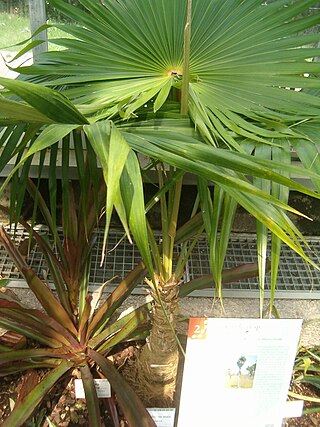
Coccothrinax alta is a palm which is native to Puerto Rico and the Virgin Islands.
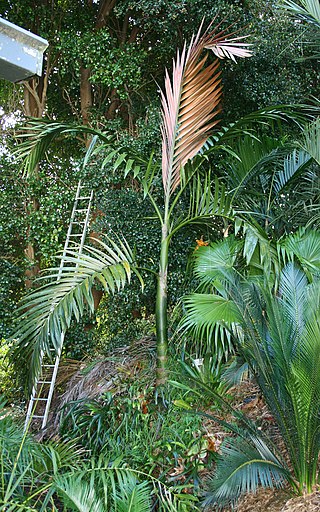
Chambeyronia macrocarpa is a species of palm tree commonly known as the red leaf palm. It is sometimes called the flamethrower palm. The species is endemic to New Caledonia.

Hyophorbe amaricaulis is a species of palm tree of the order Arecales, family Arecaceae, subfamily Arecoideae, tribe Chamaedoreeae. It is found exclusively on the island of Mauritius, and only a single surviving specimen has been documented in the Curepipe Botanic Gardens in Curepipe. Thus, it is classified as an endling.
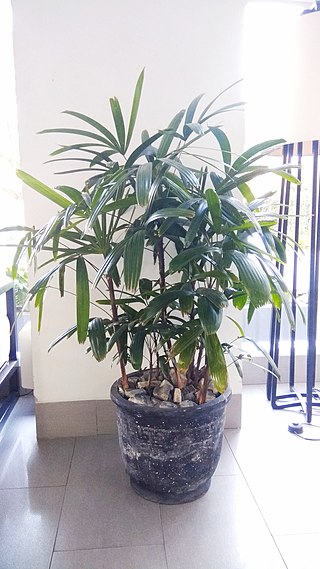
Rhapis excelsa, also known as broadleaf lady palm or bamboo palm, is a species of fan palm in the genus Rhapis. It is native to southern China and northern Vietnam. The genus name is Greek - rhapis, meaning "needle"; and the species name is Latin for "tall", though R. excelsa is not the tallest in the genus.
The wildlife of Mauritius consists of its flora and fauna. Mauritius is located in the Indian Ocean to the east of Madagascar. Due to its isolation, it has a relatively low diversity of wildlife; however, a high proportion of these are endemic species occurring nowhere else in the world. Many of these are now threatened with extinction because of human activities including habitat destruction and the introduction of non-native species. Some have already become extinct, most famously the dodo which disappeared in the 17th century.

Hyophorbe indica, known commonly as palmier bâtard, palmiste poison, or champagne palm, is a species of flowering plant in the family Arecaceae. It is endemic to the island of Réunion. It is threatened by habitat loss.

Hyophorbe lagenicaulis, the bottle palm or palmiste gargoulette, is a species of flowering plant in the family Arecaceae. It is native to Round Island, Mauritius.

Hyophorbe vaughanii is a species of flowering plant in the family Arecaceae that is endemic to Mauritius. Its natural habitat is subtropical or tropical dry forests.

Hyophorbe verschaffeltii, the palmiste marron or spindle palm, is a critically endangered species of flowering plant in the family Arecaceae. It is endemic to Rodrigues island, Mauritius, but is widely grown in cultivation.

Latania verschaffeltii, the yellow latan palm, is a species of flowering plant in the family Arecaceae. It is found only on Rodrigues Island in the Indian Ocean, part of the Republic of Mauritius, 560 km east of the Island of Mauritius. It is, however, cultivated in other places as an ornamental. In the wild, the species is threatened by habitat loss.
Coccothrinax jamaicensis, the silver thatch or Jamaican silver thatch, is a fan palm that is endemic to Jamaica.

Allagoptera is a monoecious genus of flowering plant in the palm family found in South America consisting of 5 accepted species. Compared to other genera within the Cocoseae Allagoptera is described as particularly specialized. The genus name is a Greek combination of "change" and "feather", describing the full leaf; it was formerly named Diplothemium.

Actinorhytis is a monotypic genus of flowering plant in the palm family found in Oceania and southeast Asia. The lone species, Actinorhytis calapparia is a rain forest inhabitant and has very large fruit. The genus name is from two Greek words meaning 'ray' and 'fold' which describe the endosperm of the seed.

Dictyosperma is a monotypic genus of flowering plant in the palm family found in the Mascarene Islands in the Indian Ocean. The sole species, Dictyosperma album, is widely cultivated in the tropics but has been farmed to near extinction in its native habitat. It is commonly called princess palm or hurricane palm, the latter owing to its ability to withstand strong winds by easily shedding leaves. It is closely related to, and resembles, palms in the genus Archontophoenix. The genus is named from two Greek words meaning "net" and "seed" and the epithet is Latin for "white", the common color of the crownshaft at the top of the trunk.

Mauritiella is a dioecious genus of flowering plant in the palm family found in South America where it is commonly called buriti. It is named after the similar and closely related genus Mauritia.

Roystonea oleracea, sometimes known as the Caribbean royal palm, palmiste, imperial palm or cabbage palm, is a species of palm which is native to the Lesser Antilles, Colombia, Venezuela, and Trinidad and Tobago. It is also reportedly naturalized in Guyana and on the islands of Mauritius and Réunion in the Indian Ocean.
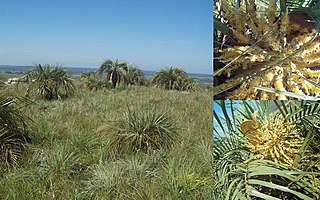
Butia paraguayensis is a species of Butia palm tree found in the cerrado region of South America. Its natural range runs from Mato Grosso do Sul and São Paulo in southern Brazil through Paraguay to northern Argentina and Uruguay. It was given the name dwarf yatay palm in English by 2000, and it is locally known as yata'i in Guaraní in Paraguay, or butiá-do-cerrado in Portuguese in Rio Grande do Sul, Brazil.
